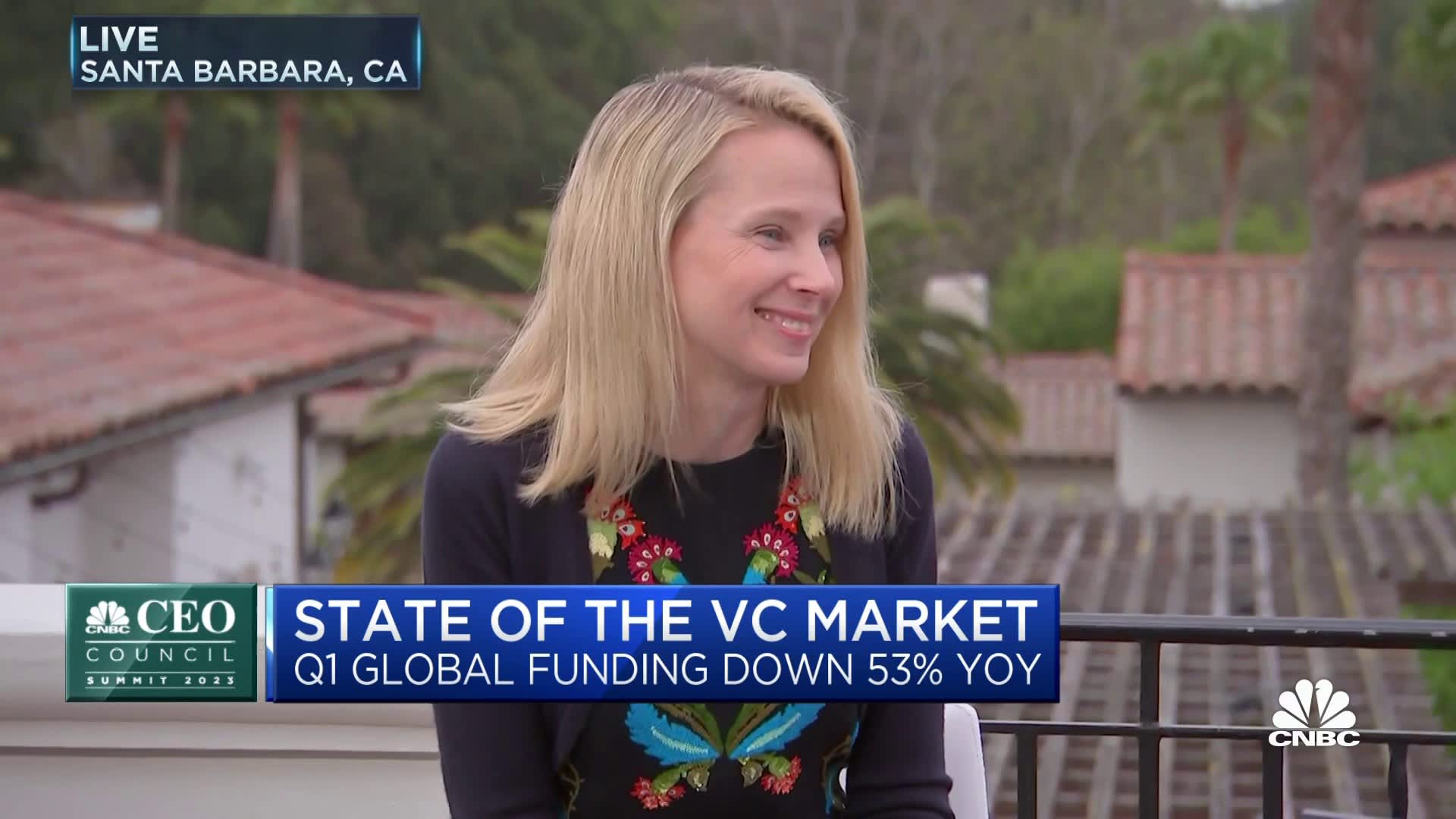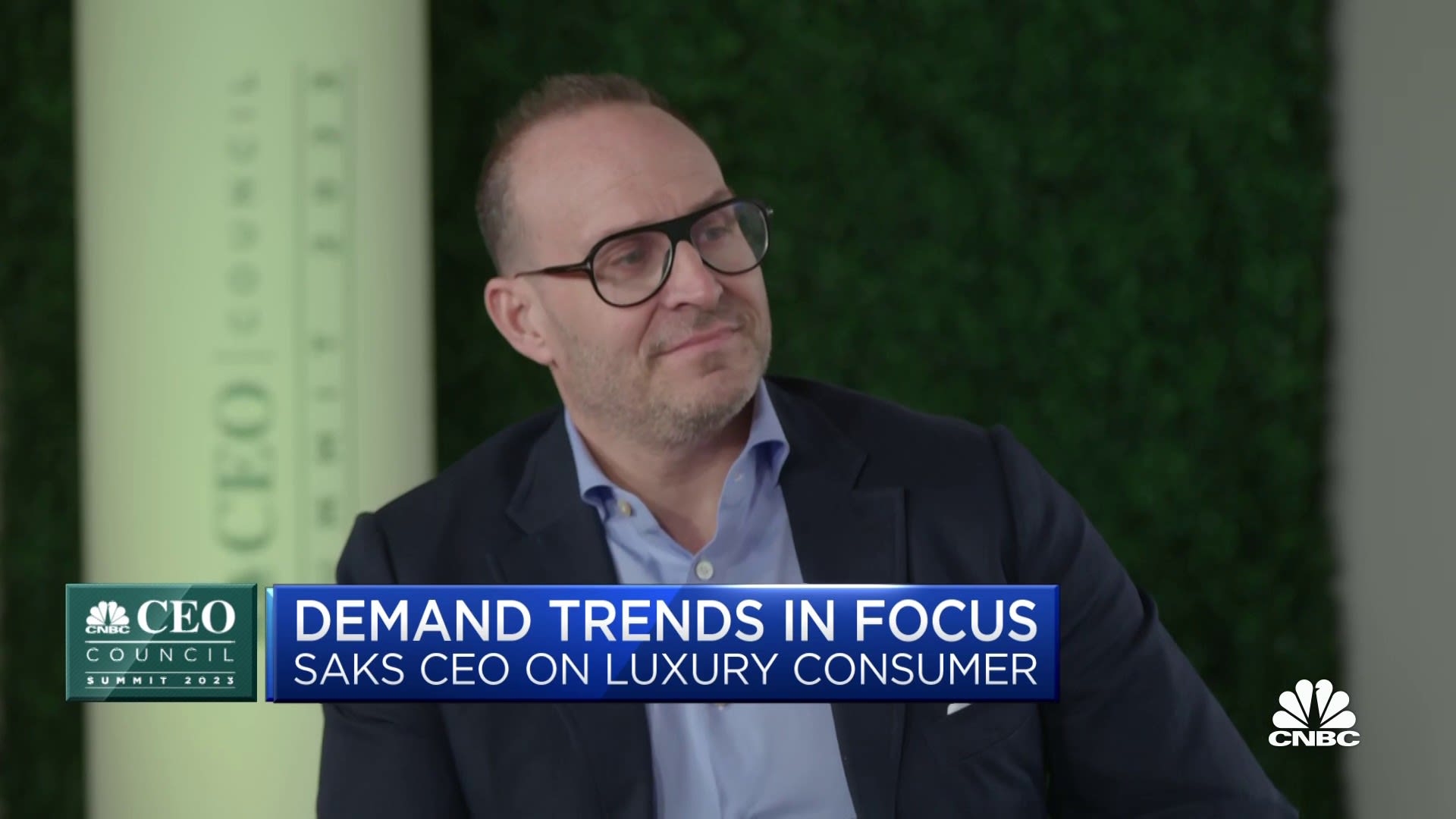
The CEO of bond investing giant TCW Group, Katie Koch, heard what she wanted to hear at this week’s CNBC CEO Council Summit. It wasn’t good news, but it matched her view of where the economy is headed. Koch, who described herself as coming into the CEO meeting “in the camp of medium to hard landing,” said she’d been surprised at recent events like the Milken Global Conference where she found executives were, in her words, “too happy.”
“CEOs are decidedly more negative,” she said of the tenure of conversations she had at the CNBC CEO event, “and I think that it’s a really, really important data point. … people are seeing real degradation, revenues being muted and job losses, so that will weigh on the economy.”
At the same time, she cited “a major call on global liquidity” which will put additional pressure on the economy and a labor market that is “starting to crack.”
That’s a view that if not shared exactly note-for-note by CEOs on an economic panel at the CNBC CEO Council Summit, did cover many of the well-known arguments for a downturn that came up in conversation on the stage between CEOs from Wall Street to the steel industry and logistics sector.
While Goldman Sachs‘ economic research team continues to believe a soft landing is possible for the economy, and Goldman CEO David Solomon told fellow CEOs “it’s hard to have a recession with full employment,” he added that his own talks with CEOs reinforce a view that economic conditions are tightening and that does have “lag effects.”
On Wednesday, the latest release of Fed minutes showed the central bank’s top officials to be split on the next interest rate move, but showing a tilt toward less aggressive policy.
The Goldman CEO is on record as having no specific for-or-against recession call, but he said, “it’s hard to tighten economic conditions and have inflation and not have an impact on growth and some rebalancing of impacts.”
If there is a recession, Solomon says he is willing to make one prediction: it will be a “shallow” one.
But Solomon, as well as other CEOs, said there is another wildcard factor in the current economy that will make whatever happens next deviate from the economic textbook.
Tamara Lundgren, CEO of Schnitzer Steel, there are two competing forces in the economy that can be seen in the demand for metals. A central bank drive to slow the global economy, on the one hand, but a commodities industry also aligned longer-term with what she described as “two extraordinary industrializing transitions.”
One is the transition to a low-carbon economy which requires a tremendous amount of metals and minerals, highlighted by copper for electrification. “We rarely see that juxtaposed with high inflation and tightening credit conditions and a drive by central banks to slow growth,” Lundgren said.
The other she cited is the rise of generative artificial intelligence which will have implications for economic production and worker productivity. Shares of Nvidia soared by as much as 25% in after-hours trading to near a $1 trillion valuation on Wednesday on the strength of AI chip demand. Earlier in the day from the CNBC summit, venture capitalist Jim Breyer had said Nvidia looks “unstoppable” over the next three years.
All of the CEOs on the panel spoke about the impact AI and machine learning are already having on their businesses and have had over the past decade, but while the Nvidia chip sales among major cloud tech players and consumer internet companies are booming, the sectors represented by CEOs at the CNBC summit were not talking in terms of huge new investments to deploy the latest generation of the technology just yet. With the latest generative AI, Goldman is working through lots of use cases and experiments, but “you want to go slow and be targeted and thoughtful and learn,” Solomon said.

In recent trading, metals led by copper have plunged in a signal of concerns about the global economy and the momentum in China’s recovery, but that comes amid longer-term belief that transitions including EVs in the auto industry will keep the metals prices on an upward trajectory.
“The structural demand for metals is very important,” Lundgren said, and right now, the competing forces are contributing to murkiness in the economic outlook. “With tightening in credit we would normally see some impact on construction, and we will see it in office construction and commercial construction and warehouse construction … but tempering that will be heavy construction through the IRA and infrastructure bills,” she said.
The importance of this structural trend can be seen from the current debt ceiling negotiations to geopolitical and economic rivalry with China.
China is the largest user of metals in world and China’s economic behavior can impact demand, Lundgren said, as it is doing right now, but the concentration of China’s control of critical minerals has become apparent to the rest of world and has led at the same time to a focus on increasing metals and mining in North America.
Citing research from Goldman Sachs commodities research head Jeffrey Currie, she referenced the “revenge of the old economy” and a moment in time when “decades of underinvestment in mining and metals” has become a key concern for the U.S. and other developed economies that need these materials for the infrastructure of a low-carbon economy.
“That’s why permitting reform is so big a part of the debt ceiling now, a big negotiating item between Biden and McCarthy,” Lundgren said.
Earlier this week, Exxon Mobil announced it was getting into domestic lithium mining in Arkansas, the key element in the current generation of EV battery chemistry, while Italian energy giant Enel said it was investing over $1 billion in an Oklahoma-based solar panel manufacturing plant, one of the biggest clean energy investments in the U.S. since the IRA passed.
Need ‘a new name’ for recession
The Congressional Budget Office’s latest score of clean energy tax breaks estimates they could cost at least $180 billion more than originally forecast because the business world’s appetite for related projects is higher than anticipated. Goldman Sachs recently forecast that Inflation Reduction Act provisions could cost as much as $1.2 trillion over the next decade, roughly three times the government forecast.
Lynn Martin, president of the NYSE, said one of the areas showing continued strength in a tough market for initial public offerings is energy transition, from traditional energy to clean energy companies.
The Dow’s recent trading downturn has come amid stalled talks this week on the debt ceiling, but CEOs at the CNBC event were more focused on the broader economic picture. Recent economic data points show that inflation is flattening, supply chains are easing up, production is easing up, and demand is slowing with consumer activity down significantly. The consumer that has been the most resilient, the high-end consumer, is cracking, according to comments from Saks CEO Marc Metrick at the CNBC CEO Council Summit.

“We are all seeing it,” Lundgren said, but she added, “you’ve got the other driver, infrastructure funds coming through the system … electric vehicles and battery and solar and wind, long-term structural drivers of demand,” she said.
There is a good possibility of recession, but she added, “Whatever this recession is, we may need a new name for it. I’m not sure history has ever seen this before.”
An increasing number of large industrial customers are opening up manufacturing facilities in North America, according to Mario Harik, the CEO of logistics company XPO, but the short-term economic picture isn’t easy to interpret. Inflation is normalizing, but the Fed needs to slow down on rate hikes as a result. Wages, which had been rising last year in the mid- to high-single digits, are now back to “pre-pandemic wage increases,” according to Harik, and the cost of transportation has come down “significantly,” even if it remains above the 2021-2022 levels.
Harik said Q1 shipments, looked at on a year-over-year basis, were up despite the economy slowing down, but two-thirds of industrials in North America and Europe are seeing “slightly softer demand than expected.” Activity has picked up a little in April, he said, and retailers are still expecting growth in the second half of the year. But overall, “very mixed signals,” he said.
Solomon expects inflation to be stickier than many people believe as it comes off its peak — rival bank CEO Jamie Dimon at JPMorgan Chase said this week that the economy should be prepared for interest rates to reach as high as 7% — and Solomon also believes we might need to see higher rates in order to control inflation.
He cited “some structural things going on” related to inflation which will make it hard to “easily” get back to the Fed’s 2% target. Even if the Fed pauses, based on what he sees now in the economy, Solomon said there is no expectation of rate cuts by the end of the year, which has been the prevailing view in the bond market.
